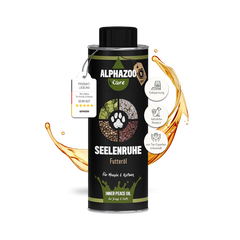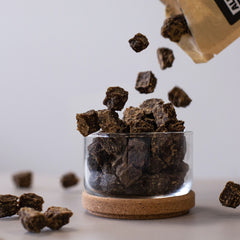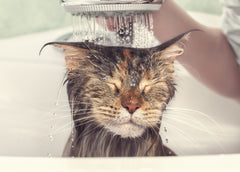Osteoarthritis in cats: When every movement becomes a challenge
Cats are true masters of the art of hiding pain. But if your normally agile cat suddenly moves less, hesitates to jump, or shows signs of pain, joint problems could be the cause. Osteoarthritis is a common but often undiagnosed condition in cats that occurs with advancing age. In this blog, you'll learn all about the causes, symptoms, and treatment options, as well as tips on how to improve your cat's quality of life.
What is osteoarthritis in cats?
Osteoarthritis, also known as degenerative joint disease, is a chronic joint disease that leads to a gradual deterioration of the cartilage that protects the joints and enables their mobility.
How does osteoarthritis develop?
- As the cartilage breaks down, the bones in the joint rub directly against each other.
- This causes pain, inflammation and limited mobility.
Affected joints in cats:
- hip joints
- Knee joints
- shoulder joints
- spine
Osteoarthritis can affect one or more joints and progresses over time if left untreated.
Typical symptoms of osteoarthritis in cats
Because cats are good at hiding pain, it's important to pay attention to subtle changes in behavior. Here are the most common signs:
Osteoarthritis symptoms in cats:
- Movement restrictions: Your cat jumps on furniture less often or not at all.
- Stiffness: The cat appears stiff and immobile, especially after getting up.
- Pain sensitivity: Your cat shows discomfort when you touch its joints.
- Reduced activity: She plays less and withdraws more often.
- Unkempt coat: Arthritis makes grooming certain areas of the body difficult.
- Changes in gait: Your cat limps or moves more slowly.
The sooner you recognize these symptoms, the better you can help your cat.
Causes of osteoarthritis in cats
The causes of osteoarthritis in cats are varied. The disease often develops due to a combination of factors:
1. Age
- Osteoarthritis often occurs in older cats because cartilage naturally deteriorates over time.
2. Injuries
- Previous injuries such as broken bones or torn ligaments can cause permanent damage to the joints.
3. Obesity
- Excess weight puts additional strain on the joints and accelerates cartilage degradation.
4. Genetic predisposition
- Certain breeds such as Maine Coon or Persian cats are more prone to joint diseases.
5. Malpositions
- Congenital or acquired misalignments of the joints can promote osteoarthritis.
6. Overuse
- Cats that jump frequently or are very active put more strain on their joints.
Diagnosis: How does the vet diagnose osteoarthritis in cats?
If you suspect your cat is suffering from osteoarthritis, you should consult a veterinarian. An accurate diagnosis is the first step toward proper treatment.
Examination methods:
- Clinical examination: The veterinarian checks the mobility and sensitivity of the joints.
- X-rays: Show changes in the joint such as cartilage degradation or bone spurs.
- Blood tests: Rule out other conditions such as inflammation or infection.
Treatment options for osteoarthritis
Osteoarthritis cannot be cured, but with the right treatment you can relieve pain and improve your cat's mobility.
1. Painkillers and anti-inflammatories
- Medications such as NSAIDs (nonsteroidal anti-inflammatory drugs) relieve pain and reduce inflammation.
2. Joint-building preparations
- Dietary supplements with glucosamine and chondroitin support cartilage regeneration.
- Omega-3 fatty acids have anti-inflammatory effects.
3. Physiotherapy
- Gentle exercise or massages promote blood circulation and mobility.
4. Weight control
- Losing weight relieves pressure on the joints and slows the progression of the disease.
5. Heat treatment
- Heat pads or heated loungers help relieve stiffness.
6. Surgical procedures
- In severe cases, operations such as joint replacement or joint fusion may be necessary.
How can you support your cat's joints?
In addition to medical treatment, there are many ways you can protect your cat's joints and improve their quality of life:
1. Comfortable berths
- Choose soft and warm places to lie down that are easily accessible.
2. Support when jumping
- Provide your cat with ramps or stairs to access furniture.
3. Regular, gentle exercise
- Encourage gentle movement to keep joints supple without overstressing them.
4. High-quality feed
- Make sure you feed your dog a balanced diet that supports joint health.
5. Joint-friendly environment
- Avoid slippery floors and create a safe environment for your cat.
Frequently asked questions about osteoarthritis in cats
“Can osteoarthritis be cured in cats?”
No, osteoarthritis is a chronic condition. However, with proper treatment, symptoms can be alleviated.
“How do I recognize osteoarthritis in my cat?”
Pay attention to symptoms such as restricted movement, sensitivity to pain, and changes in behavior.
“Do dietary supplements make sense?”
Yes, supplements containing glucosamine, chondroitin, and omega-3 fatty acids can support joints.
“Can a young cat also get osteoarthritis?”
Yes, osteoarthritis can also occur in young cats, especially after injuries or in cases of genetic predisposition.
Conclusion: Osteoarthritis in cats – early detection, correct treatment
Osteoarthritis in cats is a common but often overlooked condition. With the right treatment and targeted support, you can help your cat live a more pain-free life. The most important points at a glance:
- Symptoms: Limited mobility, sensitivity to pain, unkempt coat.
- Causes: Age, injuries, obesity and genetic factors.
- Treatment: Pain medication, physiotherapy, joint strengthening medications, and weight control.
- Prevention: High-quality nutrition, weight control and a joint-friendly environment.
Your cat will thank you if you recognize its needs and help it lead an active and happy life even with arthritis!
















